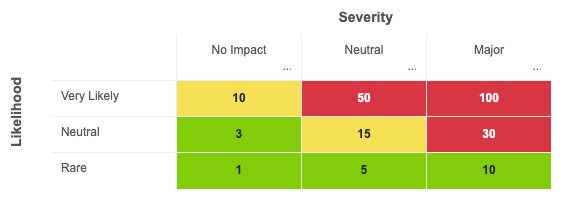QualityOne Vaults allow organizations to manage the risk associated with enterprise, operational, product, project, and customer processes using the Risk Management feature within the QualityOne QMS and HSE applications. Risk Management includes the ability to define risk levels using risk matrices, then assess related risks using risk registers. Risk Management supports creating and performing HAZOP (Hazard and Operability Studies) and P-FMEA (Process Failure Modes and Effects Analysis) types of risk studies. These tools help your organization remain compliant with the most up-to-date requirements for risk-based decision making, allowing you to control risks before they become a reality.
Note: To enable 2D and 3D risk matrices in the same Vault, contact your Veeva Representative.
Configuration Overview
Configuring your Vault to use the Risk Management feature involves the following steps:
Note: Depending on your Vault’s creation date and which features are currently enabled and configured, some of the steps described in this article may be unavailable or already complete in your Vault.
Configuring Risk Matrix Visualization
Vault can display the traditional risk matrix chart as a section in a Risk Matrix record. The visualization is a chart with colored cells corresponding to the values defined in your risk matrix for each combination of severity and likelihood.
To insert a risk matrix visualization section into a Risk Matrix object layout:
- Navigate to Admin > Configuration > Objects > Risk Matrix > Layouts.
- Select the layout you want to update.
- Click Insert Section, and choose Risk Matrix Preview.
- Enter a Label for the section.
- Click Done.
- Optional: Click and drag your Risk Matrix section to reorder.
- Click Save.
The risk matrix visualization does not display in the following cases:
- When manually created Risk Matrix Setup records have duplicate combinations of Severity and Likelihood.
- When any Severity record does not have a Column Order value.
- When any Likelihood record does not have a Row Order value.
- For three-dimensional risk matrices. Visualization is available for two-dimensional matrices only.
- When Risk Matrix Setup records are missing or deleted manually.
About Risk Matrix Dimensions
Vault calculates risk based on severity and likelihood of occurrence and displays it in a two-dimensional matrix. If enabled for your organization, you can also include detectability as the third factor in Vault’s risk calculations to convert your matrix into a three-dimensional matrix. Matrix visualization is not available for three-dimensional matrices. Once you enable detectability and build 3D risk matrices, we do not recommend turning off 3D matrices in your Vault.
Note: If you enabled Risk Management in your Vault prior to 23R3 and need to use both 2D and 3D matrices in the same Vault, you must contact your Veeva Representative to enable and configure.
Example: Qualitative Risk Matrix Visualization
Example: Quantitative Risk Matrix Visualization
Configuring Risk Management Object Actions
The Risk Study object lifecycle contains the Copy Risk Study action. This action triggers Vault to clone the related Risk Study, HAZOP Node, FMEA Process Step, and Risk Analysis records into a new set of records.
When users run the Copy Risk Study action, Vault does not copy the following:
- System-managed fields.
- Fields if the Do not copy this field in Copy Record configuration is selected.
- HAZOP Node and FMEA Process Step records if the Allow Hierarchy Copy configuration is unselected.
- A Risk Study record when more than 1,000 records are available to copy from the Risk Study record.
You can add this action as a record action on the Risk Study object or as a user action on the appropriate Risk Study Lifecycle states, depending on your business needs.
Configuring User Permissions
You must ensure users have the appropriate read and create permissions to access the appropriate objects and object fields in addition to the permissions outlined below:
- To view the risk matrix visualization, users must have the following permissions:
- Read permission on the Occurrence (
occurrence__v) object, including Read permission on the Row Order (row_order__v) field - Read permission on the Risk Level (
risk_level__v) object (for qualitative matrices only) - Read permission on the Risk Matrix (
risk_matrix__v) object - Read permission on the Risk Matrix Setup (
risk_matrix_setup__v) object, including Read permission on the following fields:- Color (
risk_level_color_icon__v) - Occurrence (
occurrence__v) - Risk Level (
risk_level__v) (for qualitative matrices only) - Risk Level Value (
risk_level_value__v) (for quantitative matrices only) - Risk Matrix (
risk_matrix__v) - Severity (
severity__v)
- Color (
- Read permission on the Severity (
severity__v) object, including Read permission on the Column Order (column_order__v) field - If your organization uses Dynamic Access Control for record-level access control, or Atomic Security to grant access depending on a record’s lifecycle state and roles, you must also grant the relevant users view access to the objects and fields listed above.
- Read permission on the Occurrence (

